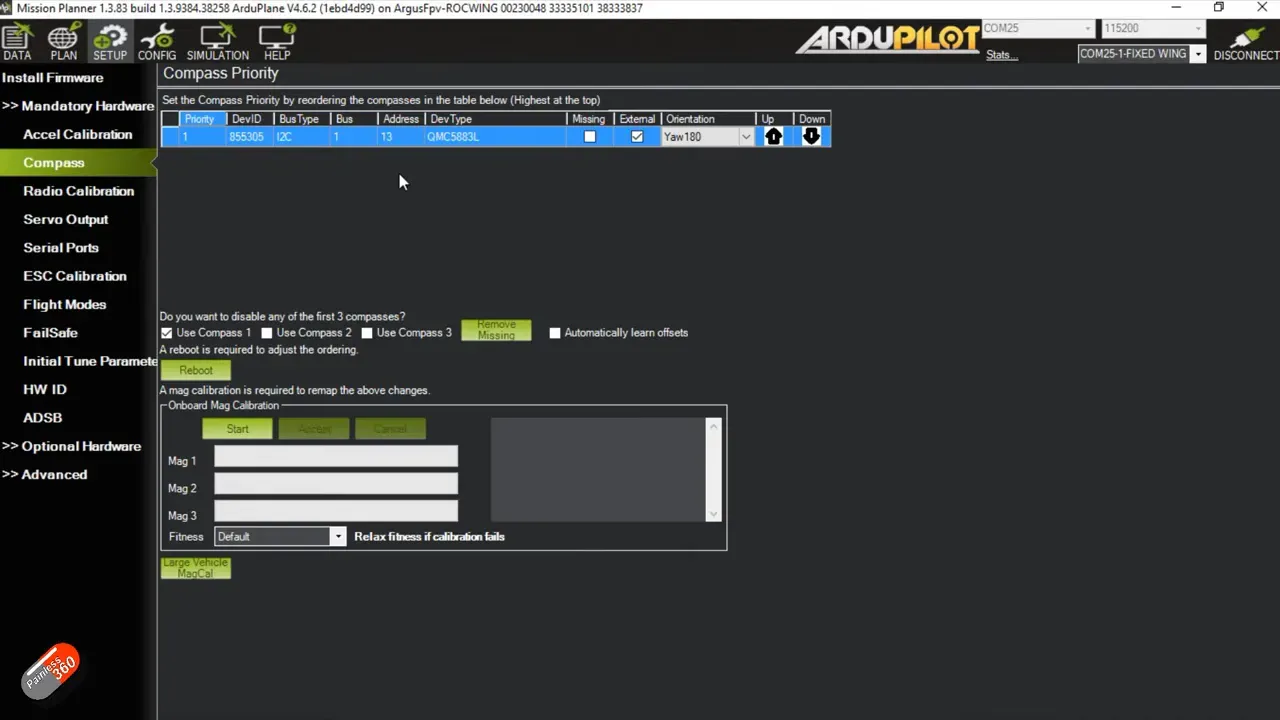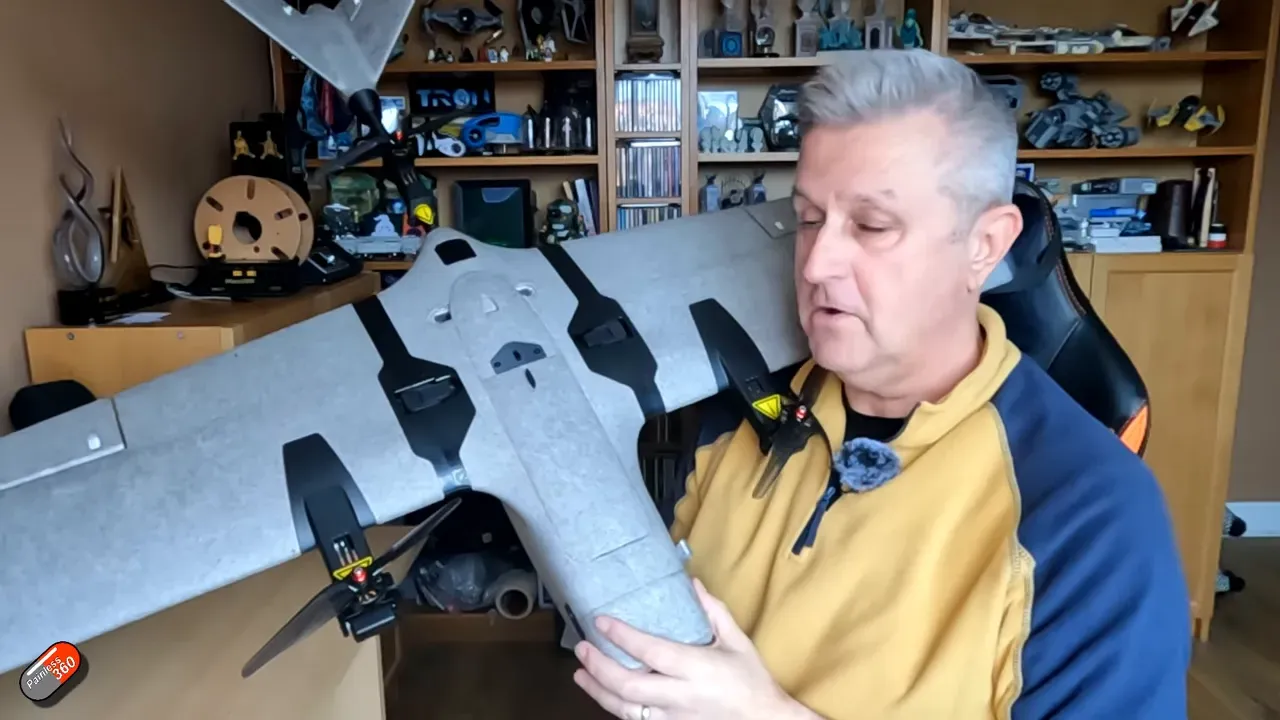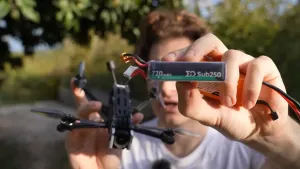
In this video Painless360 takes a first look at the ArgusFPV ROC Wing VTOL — a tilt-rotor design that might just repair his battered faith in hobby-grade VTOLs. After a bruising 2023 chasing a tune for the HEE Wing Ranger T1 and destroying a fair few airframes, he’s back on the bench with a new candidate that promises factory testing and an ArduPilot-friendly setup.
What this report covers
- Why Painless360 walked away from VTOLs in 2023 and why the ROC Wing tempted him back.
- Key specs and what they mean for real-world use.
- Unboxing and build impressions — what’s included and what’s left for you to add.
- First software check: the Argus-branded H7 flight controller with ArduPilot config.
- Planned mods and the test plan: ExpressLRS, FPV, hover/transition/cruise validation.
- Safety pointers, battery selection and links to further reading and setup guides.
Why Painless360 quit — and why he might come back
Painless360’s distrust of hobby VTOLs wasn’t an emotional decision; it was a ledger of smashed foam and broken gear. After months working with an ArduPilot developer to tame the HEE Wing Ranger T1, he lost patience with tilt-rotor craft that were shipped without reliable tunes. The result: repeated crashes and, crucially, discovery of some ArduPilot code issues around tilt-motor operation.
The ROC Wing landed on his desk because ArgusFPV answered sensible questions about factory testing and ArduPilot integration — the very things missing from many earlier consumer VTOLs.

ArgusFPV ROC Wing — headline specs and implications
- Model: ArgusFPV ROC Wing (tilt-rotor VTOL)
- Length: 917 mm
- Wingspan: Approximately 1.2 m
- Weight: ~1.4 kg (airframe only)
- Max take-off weight: 2.5 kg
- Battery: 6S recommended, ~6000 mAh (LiPo; not Li-ion)
- Construction: EPP foam with carbon spars and a mix of injection-moulded and 3D-printed parts
- Cruise: ~50 km/h (author says "50 kilometers a second" — clearly meant per hour)
- Endurance: 60–80 minutes reported (highly dependent on payload and settings)
Key takeaway: this is designed to be a long-endurance platform. Running all three motors in hover pushes power demands, hence the recommendation for 6S LiPo packs rather than lithium-ion cells.

Box contents and build impressions
Painless360 praises the packaging and the accessibility of the hardware. The ROC Wing arrives well protected, with neat bays for wings, tail, and the tilt mechanisms. Notable items:
- Pre-installed navigation LEDs on wing tips (COB strips).
- Two identical outer wing pods with branded ArgusFPV motors (no spec sticker on motors).
- Toggle-lock wing root joiners with bevelled carbon spars for easy installation.
- Front and rear hatches: battery bay under the nose hatch, FC under the rear hatch.
- Pink channel insert to route FPV and power wiring cleanly to the nose bay.
- Argus-branded H7 flight controller and an oddly-placed pitot/airspeed sensor.

The parts mix — some injection-moulded, some evidently 3D-printed — is pragmatic. The servos look metal-geared and the tail plugs together quickly with simple, hand-tight collets. Overall: build time should be minimal if you’re adding your own receiver and FPV stack.
Flight controller and ArduPilot: first laptop hookup
This is the first time Painless360 plugged the ROC Wing’s flight controller into a laptop. The H7 board enumerated cleanly and ArduPilot reported:
- External GPS+compass (Q&C 5) on a serial port.
- Airspeed sensor wired to an odd side port but detected.
- Serial port mapping with a free UART for RC in (UART6 / serial 7 recommended).
- OSD configured; standard flight modes present: Q Loiter, FBWA, Cruise and RTL.

A couple of important notes observed:
- The supplied unit in this “basic” SKU did not come radio-bound out of the box — radio calibration and arming limits need setup.
- Painless360 intends to fit ExpressLRS for RC and telemetry (recommended), and later a Walksnail/HD unit for FPV once the platform proves itself.
- Manual mode on VTOLs is explicitly flagged as dangerous; factory-supplied modes default to safe options like Q Loiter and RTL.
Planned mods and flight test plan
Painless360 will:
- Install ExpressLRS for control and telemetry (serial port planning already visible in ArduPilot).
- Keep the FPV/headset gimbal / Walksnail install for later, after initial hover/transition testing.
- Test the four key behaviours: hover, transition to forward flight, cruise performance, and transition back to hover — the exact failure modes that wrecked earlier VTOLs.

ArgusFPV claim they spent six months tuning the default configuration for these behaviours. That’s exactly the kind of vendor diligence Painless360 wants to see — because a single mis-set parameter in any of those four regimes is what usually turns a VTOL into a bag of foam and electronics.
Safety, batteries and practical tips
- Battery choice: Use a 6S LiPo ~6000 mAh (or equivalent) — avoid Li-ion for heavy hover loads.
- Pre-flight checks: Calibrate RC, verify arming voltage limits and ensure GPS/compass/airspeed are functional.
- Mode setup: Keep manual/acro modes disabled for initial flights; use Loiter/FBWA/Cruise and RTL failsafe.
- Mounting payload: Don’t stick a costly gimbal or Walksnail unit in the nose before you’ve validated hover/transition.
If you want a deeper read on VTOL tuning journeys, Painless360’s prior write-up on the HEE Wing Ranger tuning effort is relevant: https://www.unmannedtechshop.co.uk/2023/09/16/hee-wing-ranger-tuning-guide-6-month-journey-to-perfection-for-ardupilot-vtol/
Useful references and further reading
ArgusFPV ROC Wing product page: https://www.argusfpv.com/roc-wing-vtol
Helpful Painless360 videos and resources mentioned in the original video description:
- Setting up ELRS on Ardupilot: https://youtu.be/pcTjVuGcgCc
- Setting up HD FPV on Ardupilot: https://youtu.be/xfL9EKDUs2I
Conclusion — should you care?
Painless360’s first look is cautious but optimistic. The ROC Wing ticks the boxes that used to be missing in hobby VTOLs: factory testing claims, an ArduPilot-friendly H7 board and sensible physical engineering. The proof, as always, will be in flight: hover stability, smooth transitions and predictable cruise behaviour.
If you’re tempted by long-endurance tilt-rotor experiments, this is worth watching closely. Painless360 will add ExpressLRS and (eventually) a Walksnail or similar HD FPV unit and report back after hover and transition validation. If you want the nitty-gritty details, follow his channel and check the original video.
Frequently asked questions
What battery should I use with the ROC Wing?
Use a 6S LiPo around 6000 mAh as recommended by ArgusFPV. Avoid lithium-ion for heavy hover loads because the instantaneous discharge demands can be higher than Li-ion handles safely.
Does the ROC Wing come ready-to-fly out of the box?
The basic SKU Painless360 reviewed arrives with the airframe, motors, servos and flight controller but typically requires you to add your own radio receiver (he plans ExpressLRS), FPV gear and battery. Higher SKUs may include more pre-configured items.
Can I mount a Walksnail or gimbal straight away?
Don’t put expensive FPV or gimbals in the nose before validating hover and transitions. Painless360 will only fit a Walksnail/HD system after he’s sure the tilt/ArduPilot configuration is stable in all flight regimes.
Is it safe to allow manual flight mode on a VTOL?
No. Painless360 warns that manual mode on VTOLs is risky for hobbyists. Stick to Q Loiter, FBWA, Cruise and RTL for initial flights and set failsafe to RTL.
Where can I learn about binding ExpressLRS to ArduPilot?
https://www.unmannedtechshop.co.uk/2023/07/15/take-flight-a-beginners-guide-to-binding-expresslrs-receivers/
This article was created from the video ArgusFPV ROC Wing VTOL: First look at a new VTOL.







